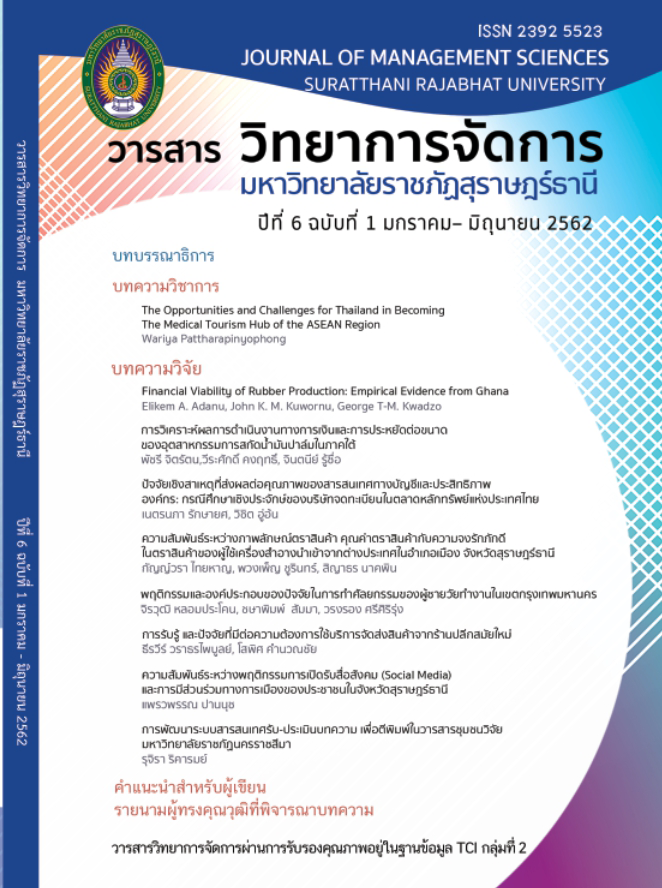The Relationship between Behavior of Social Media Exposure and Political Participation of People in Suratthani Province
Main Article Content
Abstract
The objectives of this research were to study social media exposure behaviors of political information, political participation and the relationship between behavior of Social Media exposure and political participation of people in Suratthani Province. The quantitative method was used for this research. Questionnaires were used to collect data from 400 samples. The data were analyzed by using frequency, percentage, mean, standard deviation and Pearson’s correlation. The results of this study showed as follows: The samples mostly were females aged between 20 - 29 years old, graduated in secondary education and worked as self-employed. The sampling population used Facebook on smartphone for accessing political information. The frequency of exposure was 3 - 4 times per week and they spent 31 - 45 minutes. Besides, the social media exposure of political content was medium level and the most exposure was political situations. The political participation on online social media spaces was at a low level and the most participation was information and communication. The political participation on offline spaces was at a medium level and the most participation was activity of politics. The results of hypothesis testing revealed that the relationship between the social media exposure behaviors of political information and the political participation on online social media spaces were positively correlated with high levels and the political participation on offline spaces was positively correlated with medium levels. In addition, the relationship between the political participation on online social media spaces and the political participation on offline spaces was positively correlated with the highest level with significance at the 0.01 level.
Article Details
References
กาญจนา แก้วเทพ และสมสุข หินวิมาน. (2553). สายธารแห่งนักคิดทฤษฎีเศรษฐศาสตร์การเมืองกับสื่อสารศึกษา. กรุงเทพฯ: ภาพพิมพ์.
นันทวิช เหล่าวิชยา. (2556). ความสัมพันธ์ระหว่าง พฤติกรรมการเปิดรับสื่อออนไลน์ทางการเมืองทัศนคติทางการเมือง และพฤติกรรมการมีส่วนร่วมทางการเมืองของประชาชนในเขตกรุงเทพฯ: มหาวิทยาลัยกรุงเทพ.
นภดล ปันติ๊บ. (2552). การมีส่วนร่วมทางการเมืองผ่านระบบเครือข่ายอินเตอร์เน็ตของกลุ่มเยาวชนพันธมิตรประชาชนเพื่อประชาธิปไตยเชียงใหม่. (วิทยานิพนธ์ปริญญามหาบัณฑิต, มหาวิทยาลัยเชียงใหม่).
ยุบล เบ็ญจรงค์กิจ. (2534). การวิเคราะห์ผู้รับสาร. กรุงเทพฯ: คณะนิเทศศาสตร์ จุฬาลงกรณ์มหาวิทยาลัย.
ศรัญญา ไชยวรรณ. (2554). สื่อใหม่ในสังคมการเมืองไทย กรณีศึกษา เฟซบุ๊ก วอยส์ทีวี สื่อใหม่ในสังคมการเมืองไทย กรณีศึกษา เฟซบุ๊ต วอยส์ทีวี. (วิทยานิพนธ์ปริญญามหาบัณฑิต, มหาวิทยาลัยเชียงใหม่).
สมบัติ ธำรงธัญวงศ์. (2548). การเมือง แนวคิดและการพัฒนา. กรุงเทพฯ: สำนักพิมพ์เสมาธรรม.
สิทธิพันธ์ พุทธหุน. (2541). ทฤษฎีพัฒนาการเมือง. กรุงเทพฯ: มหาวิทยาลัยรามคำแหง.
อาทิตย์ สุริยะวงศ์กุล. (2555). การเมืองบนเฟซบุ๊ก: วัฒนธรรม-การเมืองบนเครือข่ายสังคมออนไลน์ไทยพ.ศ. 2553 - 2555. (วิทยานิพนธ์ปริญญามหาบัณฑิต, มหาวิทยาลัยธรรมศาสตร์).
อุบลวรรณ อยู่สุข. (2551). บทบาทของสื่ออินเตอร์เน็ตต่อกระบวนการมีส่วนร่วมทางการเมืองไทย. มหาวิทยาลัยแม่โจ้ - แพร่ เฉลิมพระเกียรติ.
Todd Hunt and. Brent d. Ruben. (1993). Mass Communication : Producers and Consumers. New York: Harper Collins College Publishers.
Klapper, J.T. (1960). The Effects of Mass Communication Free Press. New York: Prentice Hall.

